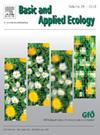大黄蜂工蜂避免在繁忙道路的边缘觅食
IF 3.5
2区 环境科学与生态学
Q2 ECOLOGY
引用次数: 0
摘要
道路边缘可以容纳多种开花植物,在花卉丰富的栖息地稀缺的景观中,可能是授粉昆虫的有用觅食栖息地。有针对性的道路边缘管理可以进一步提高花卉的丰度,从而潜在地有利于访花昆虫。然而,邻近道路上的交通可能会带来风险,例如,鲜花盛开的道路边缘反而会成为生态陷阱,吸引访花昆虫进入危险的环境。为了调查道路边缘是否适合实施传粉媒介促进行动,了解与这些栖息地相关的风险是很重要的。通过在12个道路边缘放置3个商业大黄蜂群体,每个群体都有单独标记的工蜂,我们研究了交通强度是否影响工蜂个体死亡率、工蜂行为和群体生长。我们每周访问蚁群,以确定工蜂离开巢穴前往最近的道路边缘的频率,以及在穿越道路时,它们会在多高的地方这样做。只有10%的离开的工人被观察到过马路,65%的人过马路的高度超过1.5米,相当于一辆普通轿车的高度。蜜蜂离巢时向最近的道路边缘移动的比例随着交通强度的增加而下降。大约22%的人以每24小时100辆的速度向道路边缘行驶,而只有7%的人以每天2万辆的速度向这个方向行驶。我们认为,大黄蜂避免在有过往车辆干扰的道路边缘觅食,这可能会保护它们免受交通相关的死亡。事实上,我们没有发现交通影响个体工蜂死亡率或蜂群重量变化的证据。我们的结论是,交通不会对大黄蜂工蜂构成严重威胁,因为它们会避免飞向道路。因此,适应性管理的好处可能受到交通的限制,应针对交通量低的道路。本文章由计算机程序翻译,如有差异,请以英文原文为准。
Bumblebee workers avoid foraging in road verges along busy roads
Road verges can harbour a diversity of flowering plants and may be useful foraging habitats for pollinating insects in landscapes where flower-rich habitats are scarce. Targeted management of road verges can further enhance flower abundance, thereby potentially benefitting flower-visiting insects. However, traffic on the adjacent road could pose a risk, such that flower-rich road verges instead act as ecological traps, attracting flower-visiting insects to a hazardous environment. To investigate the suitability of road verges for the implementation of pollinator promoting actions, it is important to understand the risks associated with these habitats. By placing three commercial bumblebee colonies with individually tagged workers at each of 12 road verges, we studied whether traffic intensity influenced individual worker mortality, worker behaviour, and colony growth. We visited the colonies weekly to determine how frequently workers leaving the nest headed towards the nearest road verge and, when crossing the road, at what height they did so. Only 10 % of the departing workers were observed to cross the road and 65 % of these crossings occurred higher than 1.5 m, corresponding to the height of an average passenger car. The proportion of bees heading towards the nearest road verge when leaving the nest declined with traffic intensity. About 22 % headed towards road verge at 100 vehicles/24 h, whereas only 7 % departed in this direction at 20,000 vehicles/day. We suggest that the bumblebees avoided foraging in road verges with disturbing turbulence from passing vehicles, potentially protecting them from traffic-related mortality. Indeed, we found no evidence for traffic to influence individual worker mortality or colony weight change. We conclude that traffic does not pose a severe threat to bumblebee workers, as they avoid flying towards the road. The benefit of adapted management may therefore be limited by traffic and should be targeted to roads with low traffic.
求助全文
通过发布文献求助,成功后即可免费获取论文全文。
去求助
来源期刊

Basic and Applied Ecology
环境科学-生态学
CiteScore
6.90
自引率
5.30%
发文量
103
审稿时长
10.6 weeks
期刊介绍:
Basic and Applied Ecology provides a forum in which significant advances and ideas can be rapidly communicated to a wide audience. Basic and Applied Ecology publishes original contributions, perspectives and reviews from all areas of basic and applied ecology. Ecologists from all countries are invited to publish ecological research of international interest in its pages. There is no bias with regard to taxon or geographical area.
 求助内容:
求助内容: 应助结果提醒方式:
应助结果提醒方式:


